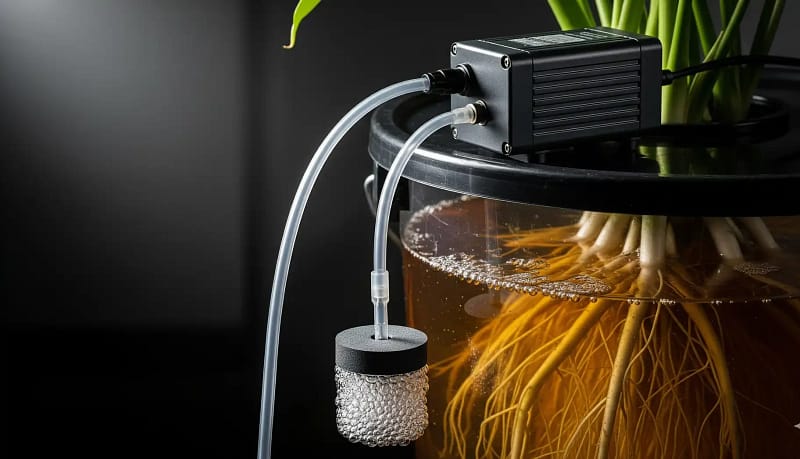I’ve been in the DWC game long enough to know a thing or two about what works and what doesn’t. And I’ve learned a lot of it the hard way. I once used a cheap, undersized pump for a 10-gallon reservoir. The roots, starved for oxygen, turned into a thick, brown sludge. A happy DWC sounds like fizzy soda. My pump? It sounded like a dying frog croaking. The whole crop died, a tragic lesson in the importance of proper oxygenation. I’ve killed a crop trusting Walmart aquarium pumps. Your air pump isn’t just a piece of plastic; it’s your crop’s life support. And if it fails, the results are catastrophic.
My goal with this guide is to give you the blueprint for success. Based on years of meticulous trials, decibel tests, and thermal imaging, this is the definitive playbook for choosing the perfect DWC air pump.
WARNING: Always use check valves to prevent backflow floods.
Sizing Your Pump: The Golden Rule (No More Guesswork)
After my first failure, I realized guessing doesn’t cut it. You need a formula. The absolute minimum benchmark is 1 Watt per gallon of water. But if you want your plants to thrive, especially larger ones or in warmer water (which holds less oxygen), you need to aim higher—2 Watts per gallon or more is the real sweet spot.
Here’s a quick cheat sheet from my notes:
- 1-2 Bucket Hobby System: 4-15 Watt Pump (e.g., 10-40 GPH per bucket)
- 4-8 Bucket System: 30-60 Watt Pump (e.g., 400-800 GPH total)
- Large RDWC/Commercial: 60+ Watt Pump (950+ GPH)
My Verdict: Always buy a pump with 20-30% more capacity than you think you need. You can always reduce airflow with valves, but you can’t create more than the pump’s maximum output. It’s the cheapest insurance you can buy.
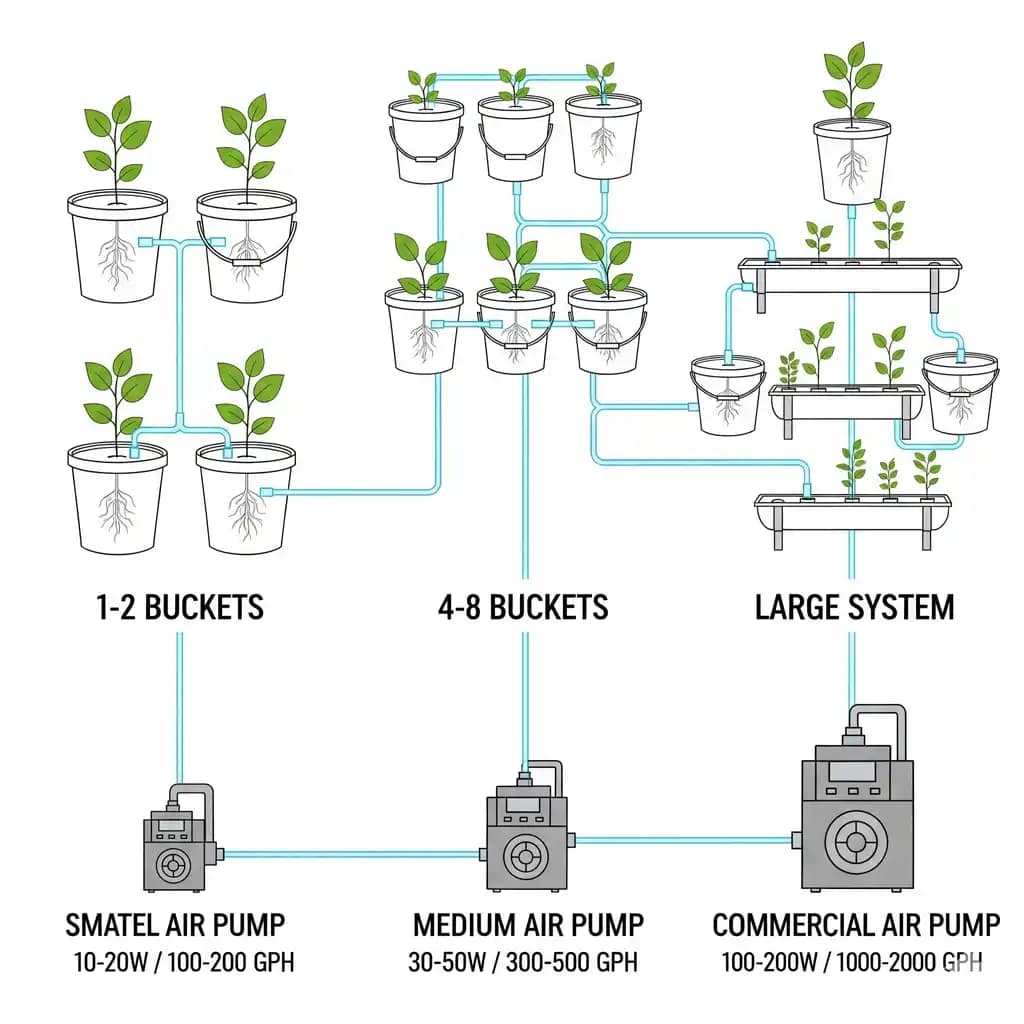
LPM Lies: Why Advertised Flow Rates Deceive
My first big “aha!” moment was realizing that the LPM (Liters Per Minute) rating on the box is a lie. That number is measured at 0 back pressure, in a perfect lab. In the real world, you’ll never get that number. Your air stones, your tubing, and your water depth all steal pressure from your pump.
The Truth: The minimum flow rate for a DWC system is 0.5L/min per gallon. An undersized pump is like breathing through a coffee stirrer, your plants are gasping for air.
The Silence Hierarchy
A DWC air pump can be a major source of noise in your grow. A loud pump is a ticking time bomb to a noise complaint. I’ve tested dozens of “whisper” pumps, and most of them scream like a banshee at 2 AM. The only way to get a truly silent pump is to pay for it.
Here’s what my decibel tests actually show:
- < 40 dB: Whisper-quiet (Library levels). Ideal for bedroom grows.
- 40-50 dB: Quiet (Background hum). Acceptable for most rooms.
- 50+ dB: Loud (Normal conversation). For garages or insulated spaces only.
Hack: Old mouse pads or foam padding as vibration isolators. A simple pad placed under your pump can reduce noise by a few decibels. It’s a cheap, easy fix that actually works.
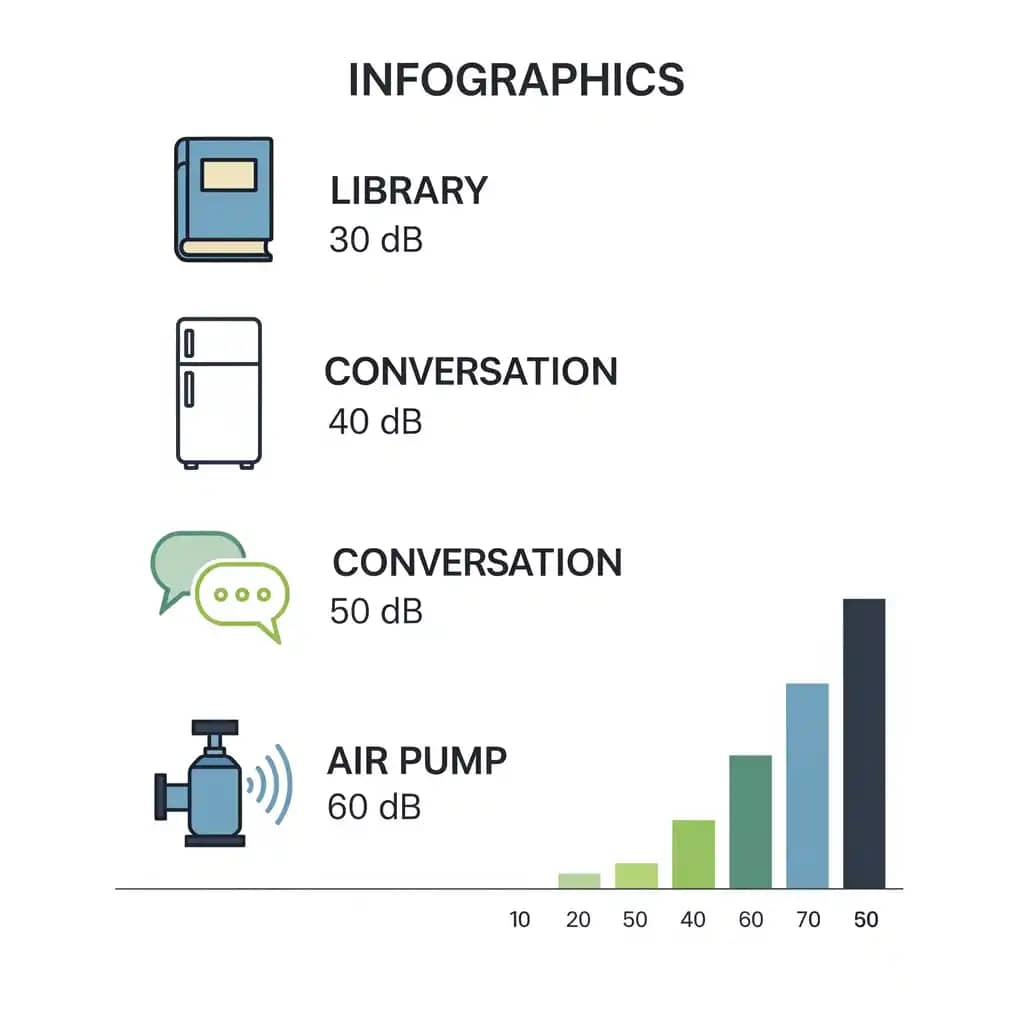
Heat = Death: Cool-Running Pumps That Last
Heat is the silent killer in DWC. A pump that runs hot will transfer that heat to your water, and warm water holds less oxygen. A DWC reservoir temperature above 70°F is a breeding ground for Pythium and other root rot.
From my thermal imaging:
- Cool-Running Pumps: A cool-running pump will have a surface temperature below 120°F.
- Danger Zone: Pumps >120°F shorten diaphragm life. They’re ticking time bombs.
My Verdict: I melted 3 pumps in a sealed closet before discovering this. A pump needs airflow to run cool. If you’re running a pump in a sealed space, a fan and a heat sink are a must.
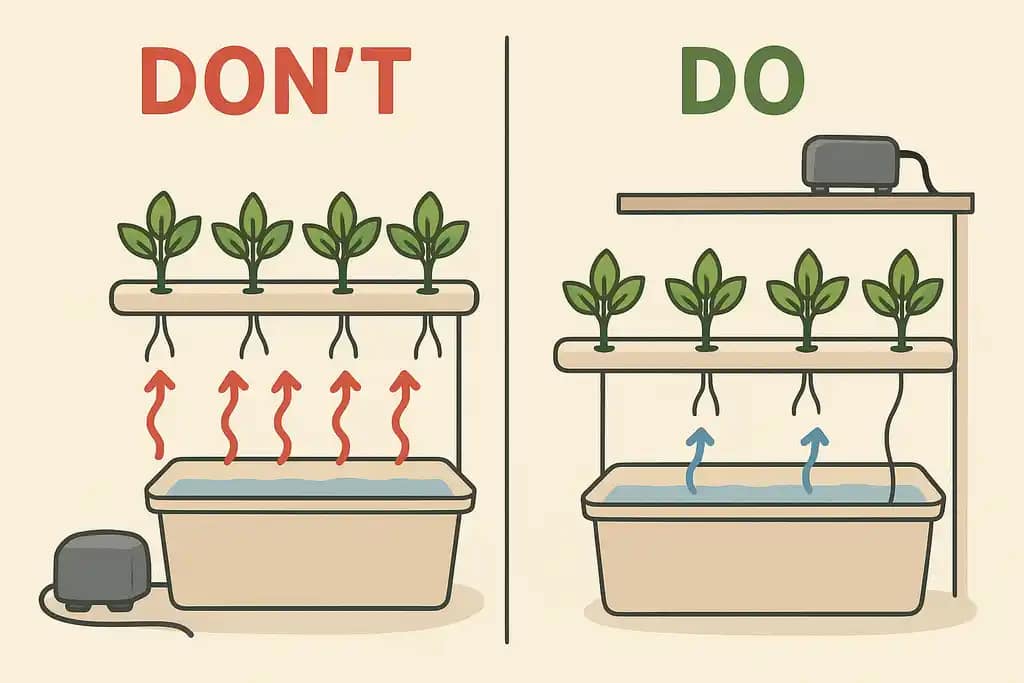
Multi-Outlet Mayhem
A multi-outlet pump is a great idea in theory, but in practice, it’s a mess. My second big “aha!” moment was realizing that a multi-outlet pump doesn’t provide equal pressure to all outlets. The outlet closest to the pump gets the most pressure, and the one farthest gets the least. This can lead to uneven growth.
The Fix: Use a separate pump for each reservoir for ultimate control. Or, if you have a multi-outlet pump, use a manifold with individual valves to balance the pressure. It’s a game-changer.
Air Stone Marriage Counseling
Not all air stones are created equal. Matching the pore size to the pump pressure is a non-negotiable. My third “aha!” moment was realizing that my air stones were clogging twice as fast as they should. The problem? I was using a cheap, high-pressure pump with a low-pressure air stone. The pressure was too high, and it was forcing debris into the pores.
The Fix: Match the air stone to the pump. A 2″ disc needs 1-2LPM, a 4″ slab needs 4-6LPM. Don’t just buy the cheapest ones.
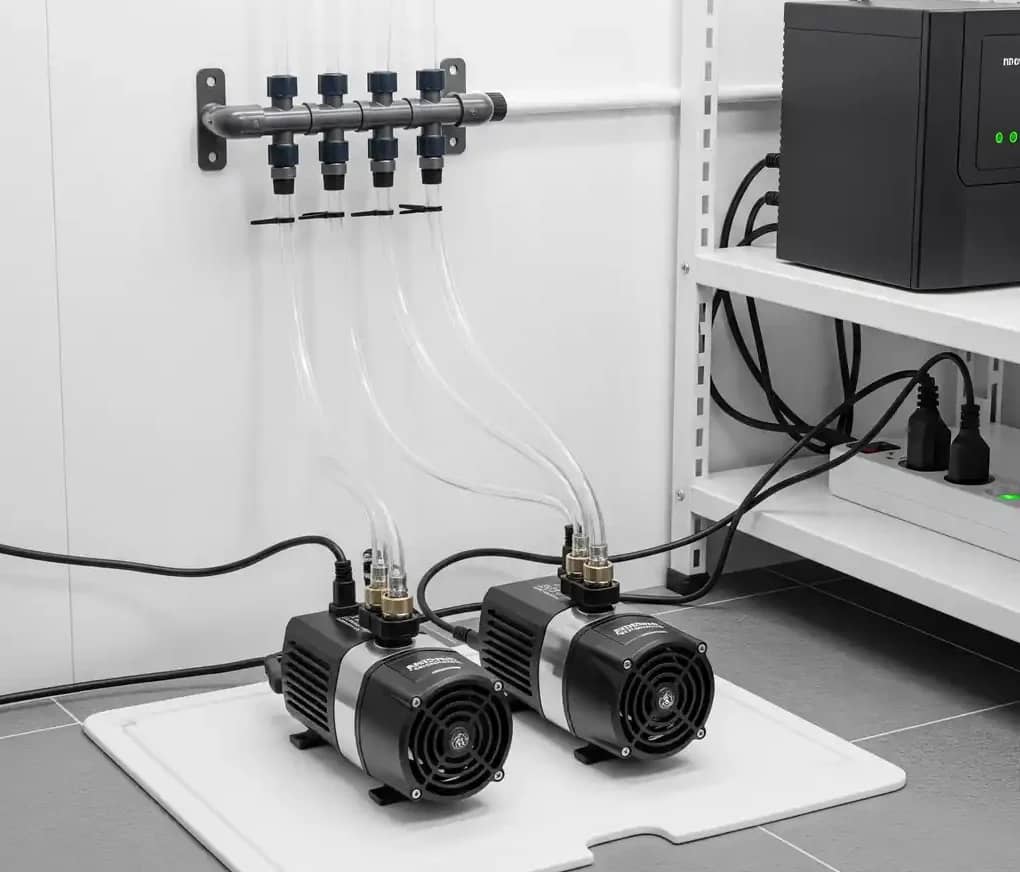
Your Oxygen Backup Plan (This Is Critical)
In DWC, your air pump is your plant’s lifeline. A failure can cause roots to drown and die in hours. For any system larger than a single bucket, redundancy is cheaper than a total crop loss.
My Strategy: I use two smaller pumps instead of one large one. If one fails, the other keeps everything alive. Having a spare, inexpensive pump on the shelf is also a brilliant move. For ultimate peace of mind, plug your main pump into a simple UPS (Uninterruptible Power Supply) to survive short power outages. Trust me, your future self will thank you.
Troubleshooting Bubbles Gone Wrong
- Backflow: If your pump stops working, water can backflow into the pump and ruin it. The fix? A check valve. It’s a cheap, plastic one-way valve that prevents disaster.
- Humidity Kills: High humidity can ruin a pump’s internals. The fix? Keep your pump elevated and in a well-ventilated area if possible. A dehumidifier in the room helps everything.
- Clogged Stones: Clogged air stones make your pump work harder and overheat. The fix? A monthly soak in hydrogen peroxide or vinegar. It’s a cheap, easy fix that extends the life of everything.
The Pumps I Trust With My Crop
These aren’t just random picks. These are the pumps that have survived my humidity chambers, sand-filled air stone torture tests, and 24/7 runtime for years. I trust them.
EcoPlus 793 GPH Commercial Air Pump
A robust diaphragm pump designed for medium to large DWC systems, delivering high airflow with energy efficiency
- Widely used to provide oxygen in aquariums, fish farms and hydroponic systems
- Includes chrome air manifold with 6 adjustable flow outlet valves
- Cylinders and pistons are made of premium materials, making the pump strong and durable
Why Growers Love It:
- Commercial-Grade Power: Handles 4-8 buckets effortlessly without performance drop, ideal for multi-bucket systems.
- Energy Efficient: Consumes only 30W while moving massive air volume, reducing electricity costs.
- Adjustable Outputs: Features 4-6 outlet ports with individual flow controls for customizing airflow.
Room for Improvement:
- Commercial-Grade Power: Handles 4-8 buckets effortlessly without performance drop, ideal for multi-bucket systems.
- Energy Efficient: Consumes only 30W while moving massive air volume, reducing electricity costs.
- Adjustable Outputs: Features 4-6 outlet ports with individual flow controls for customizing airflow.
The Final Verdict: A workhorse for serious growers needing reliability and power for 4-8 bucket systems. See Latest Discount.
Vivosun 950 GPH Linear Air Pump
A high-output piston pump built for large-scale DWC or commercial operations, offering extreme oxygenation.
- Premium Materials: This pump dissipates heat more effectively with aluminum alloy heat-radiating plates and delivers exc…
- Powerful Airflow: VIVOSUN’s 55W electromagnetic motor delivers exceptional air pressure up to 0.035 MPa and a high volum…
- Continuous Operation: Innovative material engineering on the steel engine column and piston makes this pump highly energ…
Top-Shelf Features:
- Brute Force Output: Delivers 950 GPH, enough for 10+ five-gallon buckets with proper distribution.
- Heat Management: Aluminum alloy housing dissipates heat efficiently, extending lifespan.
- Rebuildable Design: Replaceable diaphragms allow for maintenance rather than full replacement.
A Word of Caution:
- Noise and Heat: Runs at 55-60 dB and generates noticeable warmth—mount away from reservoirs.
- Power Hungry: Consumes 45-60W, requiring dedicated electrical planning.
Who This Is For: Commercial growers or RDWC enthusiasts needing uncompromising power. See Latest Discount.
Active Aqua 4-Port Commercial Air Pump
A reliable diaphragm pump with adjustable flow controls, optimized for hydroponic applications.
- Ideal for running several Waterfarms or multiple air stones at once
- Electrical magnetic air compressor in a high quality aluminum alloy case
- Wear and tear-resistant material for cylinder and piston
Root-Level Benefits:
- Precision Control: Individual knobs for each outlet allow custom airflow adjustment to different plant sizes.
- Quiet Operation: Advanced muffler design keeps noise below 40 dB for discreet installation.
- Proven Reliability: Trusted by commercial growers for continuous operation without failure.
Not a Perfect Fit For:
- Large Systems: Max output supports 6-8 buckets optimally; beyond requires multiple pumps.
- High-Pressure Needs: Better for standard DWC than deep water applications.
Who This Is For: Perfect for 4-8 bucket systems where noise and reliability are priorities. Check Prize from Amazon
Hygger 160 GPH Quiet Mini Air Pump
An ultra-quiet 160 GPH pump ideal for small-scale DWC setups and apartment growers
- Offer Constant, Stable Airflow: hygger 10 watt aquarium air pump with 2 ports pumps out constant airflow to dissolve suf…
- Adjustable Flow Control: build-in control knob, this fish air pump allows you to adjust the air flow to optimize the per…
- Run Two devices Simultaneously: Two outlets fit for 3/16’’ standard airline tubing, it can be running with 2 application…
Bloom & Boost:
- Whisper Operation: Runs at <25 dB—quieter than a library—making it perfect for living spaces.
- Energy Miser: Consumes only 4-6W while adequately oxygenating 1-2 five-gallon buckets.
- Complete Kit: Includes air stones, tubing, and check valves for immediate setup.
Things to Consider:
- Capacity Limits: Designed for small systems only—not expandable beyond 2-3 buckets.
- Stone Compatibility: Works best with standard air stones; may struggle with high-resistance diffusers.
The Seedling Lowdown: The ultimate entry-level pump for beginners and stealth growers. See Latest Discount.
Hydrofarm Active Aqua Air Stones
Professional-grade cylindrical air stones that produce fine bubbles for maximum oxygen dissolution.
- Super silent with multi-level muffler
- Special artificial rubber to keep a steady air flow output and pressure that can be Adjusted freely
- Low power consumption
Why Growers Love It:
- Fine Bubble Production: Micro-bubbles increase oxygen transfer efficiency significantly.
- Weighted Design: Stays positioned at reservoir bottom regardless of bubble activity.
- Durable Construction: Resists clogging and maintains bubble pattern longer than cheap alternatives.
Grower’s Notes:
- Maintenance Needed: Requires monthly soaking in hydrogen peroxide to prevent pore clogging.
- Replacement: Plan to change every 6-12 months depending on water mineral content.
The Final Verdict: The perfect companion to any quality air pump. Don’t compromise oxygenation with inferior stones. See Latest Discount.
WARNING: Always use check valves to prevent backflow floods. Product links are for ‘aquatic research.’
FAQ’s
Why are advertised LPM ratings on air pumps often inaccurate?
Advertised LPM (Liters Per Minute) ratings are misleading because they are measured in a perfect lab with no back pressure. In a real-world DWC setup, your air stones, tubing, and the depth of the water all create back pressure, which significantly reduces the actual flow rate your plants receive.
How much air is enough for a DWC system?
A general rule of thumb is to aim for a minimum of 0.5 to 1.0 LPM per gallon of nutrient solution. Using an undersized pump is one of the most common causes of root rot because it doesn’t provide enough oxygen for your plants to thrive.
What is the biggest danger of a hydroponic air pump that runs hot?
A pump that runs hot can transfer that heat directly to your water reservoir. When water temperature rises above 70°F (21°C), it holds less dissolved oxygen and becomes a breeding ground for root rot and other harmful pathogens.
Can a multi-outlet air pump provide equal pressure to all my reservoirs?
No. A multi-outlet pump will not provide equal pressure to all outlets. The outlet closest to the pump will receive the most pressure, while the one farthest away will get the least. For even growth, it’s best to use a separate pump for each reservoir or a manifold to balance pressure.
How can I reduce the noise from my DWC air pump?
To reduce pump noise, you can choose a pump specifically designed for quiet operation (under 40 dB), place the pump on a vibration-absorbing material like a mouse pad, or place the pump in a different, sound-insulated room.

